| |
The Shabashow-Zabow, Rykman & Gordin Families
This information was donated by TG.
Tessia Levin-Gordin has a rich Vitepsk background:
I have many roots to Vitespk:
The SHABASHOV family were from Polotsk, Nevel and Wolkova. (The surname was changed in South Africa to ZABOW)
Wolkova was an agricultural settlement near Nevel.
My GGG grandfather, Chatza Shabashov lived there in the 18th and 19th Century.
The RYKMAN family lived in Maeba / Maeva
Taube Beila Rykman, my maternal grandmother, the daughter of Chasia (???? ) Shabashova and Tuviah Avramov Rykman, from Maeva. Born 1888 in Nevel, Died 1954 in Cape Town, South Africa.
Eliyahu Jacob Shabashov, my maternal grandfather, the son of Cippa Shuli Awerbach and Avraham Shabashov. Born 1881 in Polotsk, Died 1953 in Cape Town, South Africa.
Chasia Rykman was Avraham Shabashov’s brother, making my grandparents 1st cousins.
Below is a copy of TAUBE BEILA RYKMAN and YANKEL SHABASHOV’s marriage contract, which is written in Aramaic and dated 8th August, 1906.
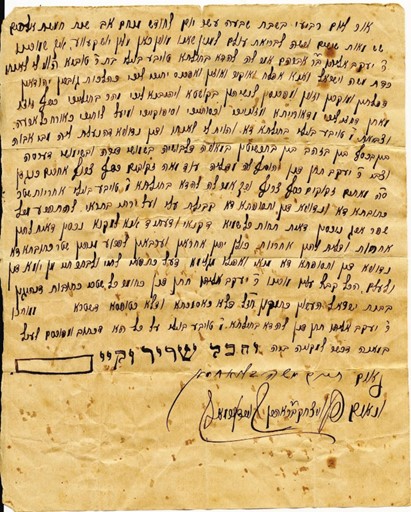
Tessia Levin-Gordin has a rich Vitepsk background:
I have many roots to Vitespk:
The SHABASHOV family were from Polotsk, Nevel and Wolkova. (The surname was changed in South Africa to ZABOW)
Wolkova was an agricultural settlement near Nevel.
My GGG grandfather, Chatza Shabashov lived there in the 18th and 19th Century.
The RYKMAN family lived in Maeba / Maeva
Taube Beila Rykman, my maternal grandmother, the daughter of Chasia (???? ) Shabashova and Tuviah Avramov Rykman, from Maeva. Born 1888 in Nevel, Died 1954 in Cape Town, South Africa.
Eliyahu Jacob Shabashov, my maternal grandfather, the son of Cippa Shuli Awerbach and Avraham Shabashov. Born 1881 in Polotsk, Died 1953 in Cape Town, South Africa.
Chasia Rykman was Avraham Shabashov’s brother, making my grandparents 1st cousins.
Below is a copy of TAUBE BEILA RYKMAN and YANKEL SHABASHOV’s marriage contract, which is written in Aramaic and dated 8th August, 1906.
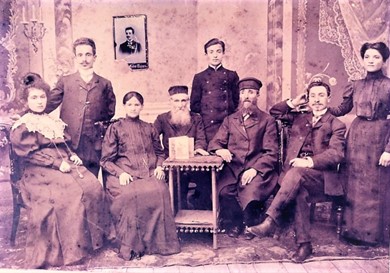
Left to Right: Taube-Beila Rykman- Zabow, Yankel Shabashov-Zabow, Chipi-Shula Auerbuch-Shabashov, Bessie(Barend) Shabashov, Akiva (Kay) Shabashov-Zabow, Abraham Shabashov, Chatzka Shabashov, Hoda Shabashov
This is a copy of their wedding invitation written in Russian and translated by Google.
The date is the pre-revolution Julian Calendar which corresponds with the Hebrew date on the Ketuba - 8.8.1906.
Abram Shabashov with his wife
I humbly ask you to welcome the marriage of their son Yankel with the maiden Beila
Teve-Levna Rykman, which is to take place on Tuesday, July 25th,1906 ( Hebrew date-Av 16) at st. Maeva M.V.R.d.
Telegram address: Maeva, Shabashovu
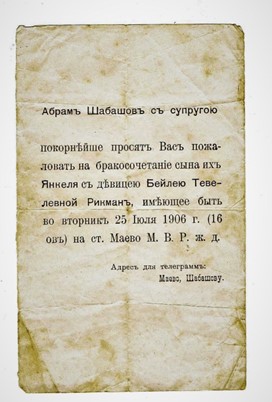
The reverse side of the invitation has a list of names and numbers in Yiddish, probably guests.
I ?nd it interesting that the invitation was written in Russian, as I don’t remember ever hearing Russian as a child. Yiddish was my mother’s home language and most of their correspondence is written in Yiddish.
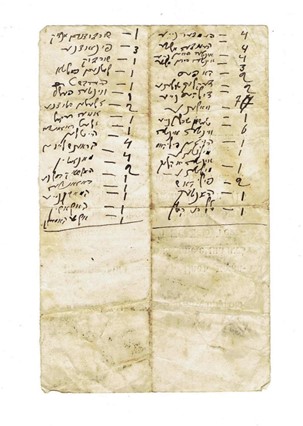
Here is a picture of my grandparents gold watch, copper pots, silver wine cups and brass candelabra (which once had crystals hanging on it.)
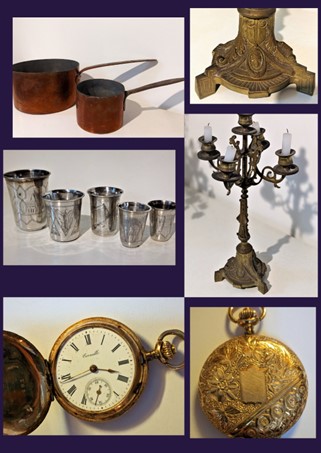
Below is a description of the watch. I have no idea of its origin.
This is an absolutely stunningly beautiful little full Hunter pocket watch made in 14ct gold. The case is engraved with a plant growing around the entire edge of the watch and across to the front and back with lines etched into the gold in the less ornate parts of the casing. The watch has no personalization. The inner cases are all engraved 14 ct, 56 ( which is stamped on all Swiss watches of this era sold to the Russian market. 56 is the Russian equivalent of the 14 ct sign.
05585 is also engraved into the watch, this is the percentage of gold the watch contains. There is also engraving in the inside of the case which is clearly visible in the photos and easily read. The dial is white with black Roman numerals, as are the hands. The dial is very fresh and unmarked and has the name Corneille. There are a few minor marks on the outer cases but nothing signi?cant or inconsistent with the age of the watch.
At age 13, Beila started preparing her trousseau. She made this crocheted lace tablecloth and long embroidered dishcloths with her initials.
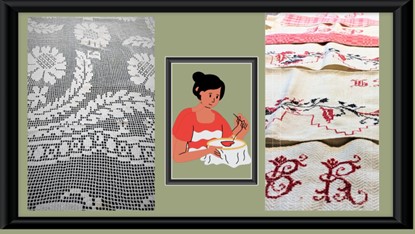
These are portraits of my maternal great grandparents, Tuviah and Chasia Rykman. The original postcard size pictures were sent to my grandparents in Cape Town, South Africa, who
sent them to Johannesburg to make large color framed portraits. My mother inherited them and asked me not to throw them away. So they are now in storage.
The next two generations were all terri?ed of this couple, whose unsmiling eyes watched us in every direction and every move!!
My Great Grandparents
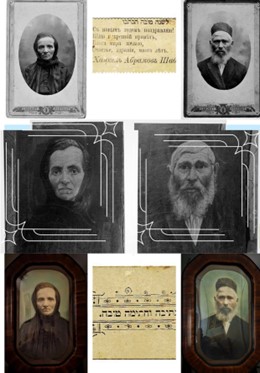
In 1909 Yankel / Jacob left Russia leaving his wife, Beila and baby son, Phillip, with his family in Polotsk. He joined 3 brothers for a short time in USA and then they were persuaded to join the rest of their brothers in South Africa, leaving 1 brother behind in USA.
Beila and 5 year old Phillip joined him in 1914. Edith, my mother, was born in 1917.
Beila corresponded with her sisters until 1945 when all correspondence ended with Soviet Russia. About 1990 a letter arrived to my parents’ business, which had been closed for several years after they had retired. The postman remembered them and passed it on to a Jewish neighbor, who contacted my parents. It was from Chasia Rykman’s great grandchildren who wanted to come on Aliyah to Israel.
When we met we were strangers, with no common language. I found it hard to accept we were cousins until they showed me photos of the portraits of Chasia and Tuviah, our great grandparents. Apparently an artist in the family had painted the same pictures, but they were declared national treasures and could not be taken out of Russia.
My grandparents.
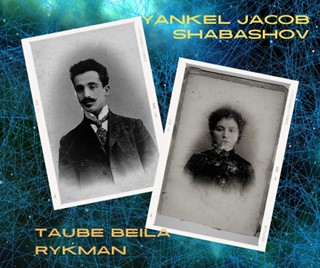
Leizer Rykman was my grandmother’s younger brother.

These are all photos I found in my grandmother’s “chocolate box”.
There is nothing written on them, nor the photographer’s location.
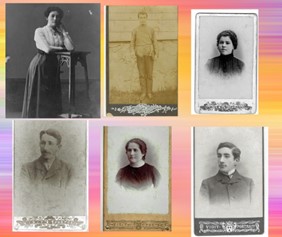
These are marked Vitepsk, Nevel and St.Peterburgh.
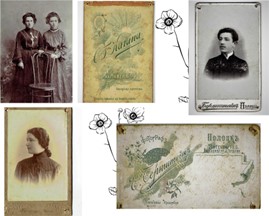
|
|